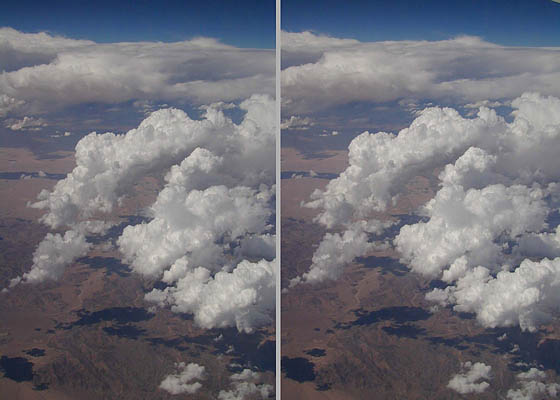
| Home |
Can I use my camera to shoot 3D pictures? Yes. But doing it right involves understanding how your eyes and brain make 3D happen, how you must create the pictures in the first place, how to display them for the best effect and how you train others to see the results. Sounds like a lot, but since this is photography, an example may speak volumes. Here is a cloud picture shot from 28,000 feet above the Mojave Desert in California. |
||
|
 Each side of this image is wider, on most computer screens, than your eyes are apart. Your eyes only focus out to the horizon because nature doesn't need them to go beyond that. At that "setting", your eyes are targeting objects with a perfectly parallel gaze. When you focus on your hand, your eyes are focusing by angling inwards to converge on the much nearer view. If you focus on an object very close to your nose, other people will see you as being downright "cross eyed". But since the pictures are wider than your gaze, the right image can't be on the right side of the page. Various
small degrees of crossed-eye "settings" are what we
all use all the time to focus on anything closer than the horizon.
Now that you know this, the images above can begin to make some
3D sense. One is made for your right eye, the other for your
left. Since they are wider than your "infinity setting",
we have placed them in Right > Left order and you have to
use a variation of crossing your eyes to see the effect. Doing
this lets you swap them so the image on the left gets into your
right eye and vice versa. If you focus on a finger held about 8 or 9 inches in front of your nose, your eyes are under no stress at all. It is easy to converge your eyes this close. Depending on your age, eyesight and glasses, if you have them, you should be able to focus at this distance easily, too. Most glasses let you focus at normal reading distance and this will help. Hold that finger up and focus on it. The image above should be beyond the finger. No, it doesn't matter which finger you use. The trick is to stop focusing on your finger and let your eyes bring the image into focus all while your eyes stay CONVERGED on your finger. Often the transition is dramatic and sudden. The mountains, clouds and horizon suddenly become a fully dimensional image. With practice, you can do this simply by crossing your eyes slightly and letting them find their focus to bring the 3D image together. Shooting a shot like this requires making a pair of images that are farther apart than your eyes are. Your eyes only give a 3D effect for about the first 25 feet (8 meters) of your world so dramatic shots like this must be made several hundred feet apart within a second or so of each other. Read the book for clues, tips, instruction and secrets of how to make 3D images with one camera that will bring full dimension to your photographic experiences. This also works in your front yard, too. Here is an image made in mine: |
|||
|
|
|||
|
You can't shoot images like this when it is windy and you can't shoot moving objects, but you can get quite a nice gallery of images in 3D with just a little help from any of the eBooks. Both of these images, for instance, were shot hand-held. This is just one of the dozens of amazing secrets of digital photography that come with any of our eBooks. |
|||